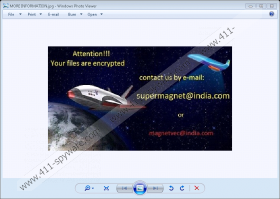Supermagnet@india.com Ransomware Removal Guide
Did you know that you could get your operating system infected with the malicious Supermagnet@india.com Ransomware just by opening a harmless-looking file? This threat is distributed via spam emails that include misleading file attachments, such as a fake invoice from the post or travel itinerary from an airline company. As you open the file, the expected content might not show up, and most victims think that an error has occurred. In reality, the malicious ransomware has slithered in, and the encryption of your documents, photos, and other personal files might begin shortly. If you realize that something is not right, you might be able to delete Supermagnet@india.com Ransomware before it initiates malicious processes. Unfortunately, most victims remain clueless about the invasion of this malware, and they realize that the infection has attacked post factum. When you realize that a malicious ransomware has corrupted your personal files, you might want to remove the malicious files as soon as possible, but you should not rush. Unfortunately, your files will remain locked even if you get rid of the ransomware successfully.
Supermagnet@india.com Ransomware is just as malicious as Asn1 Ransomware, GoldenEye Ransomware, Matrix9643@yahoo.com Ransomware, and many other ransomware infections that we have reviewed quite recently. The reality is that new ransomware threats emerge every single day because they have been proven to bring in a lot of money for devious cyber criminals. When Supermagnet@india.com Ransomware encrypts your files, it also creates a file named “decryption instructions.jpg”. This file pops up on your screen as soon as the encryption is done to inform that you need to email one of two emails (supermagnet@india.com or magnetvec@india.com). Cyber criminals use these emails for communication, and once you email them, they can introduce you to instructions that allegedly can help you decrypt your files. The main step in these instructions is paying the ransom that is requested for a decryption key. If the decryption key actually exists, the creator of the ransomware is the only one who has it. According to our researchers, you should not rely on third-party decryption programs to help you unlock your files.
Luckily, Supermagnet@india.com Ransomware does not lock the screen like some other ransomware threats can, which makes inspecting the operating system easier. You have to inspect your PC to see which files were corrupted. The files that were encrypted by the ransomware will be impossible to open, but you do not actually need to check every single file individually. All you have to do is look at the name of the file, and it will become clear if it was hit or not. The “.{supermagnet@india.com}” extension is appended to all files that are corrupted by the threat, which, by the way, is done using the AES-256 encryption key. Hopefully, you will find that the files that were corrupted are actually backed up in an external drive or online. If your files are not backed up, you have to decide whether you take the risk of paying the ransom or you come to terms with losing your files. Remember that paying the ransom is extremely risky and you could find yourself in a situation where your files remain encrypted, and your money is gone.
Whatever happens with your files and whatever you decide to do, you must not forget to remove Supermagnet@india.com Ransomware from your operating system. First and foremost remove the malicious spam email attachment file that might have executed the threat. Next, erase the ransom note that is likely to be placed on the Desktop. Finally, eliminate the malicious executable that is likely to be added to the Startup of your operating system. You can follow the instructions below if you think you are able to eliminate the malicious threat manually. If you are not experienced, it is best for you to install anti-malware software. This software will automatically erase the ransomware along with all other potentially active threats. The best part is that this software can also provide you with full-time protection afterward, and so we advise investing in it and keeping it updated at all times. If you have any questions regarding the Supermagnet@india.com Ransomware removal process or even the protection of your operating system, you can post all of them in the comments section below.
How to delete Supermagnet@india.com Ransomware
- Delete the malicious launcher file.
- Delete the ransom note file called decryption instructions.jpg.
- Launch RUN by tapping Win+R keys and enter regedit.exe.
- In Registry Editor, go to HKLM\SOFTWARE\Microsoft\Windows\CurrentVersion\Run.
- Delete the {unknown name} value that represents the location of the malicious .exe file.
- Launch Explorer by tapping Win+E keys.
- Check all of these directories to find the malicious .exe file (Deleteit when found):
- %ALLUSERSPROFILE%\Start Menu\Programs\Startup\
- %APPDATA%\Microsoft\Windows\Start Menu\Programs\Startup\
- %USERPROFILE%\Microsoft\Windows\Start Menu\Programs\Startup\
- %ALLUSERSPROFILE%\Microsoft\Windows\Start Menu\Programs\Startup\
- %ALLUSERSPROFILE%\Application Data\Microsoft\Windows\Start Menu\Programs\Startup\
- %WINDIR%\System32\
- %WINDIR%\Syswow64\
Supermagnet@india.com Ransomware Screenshots:



